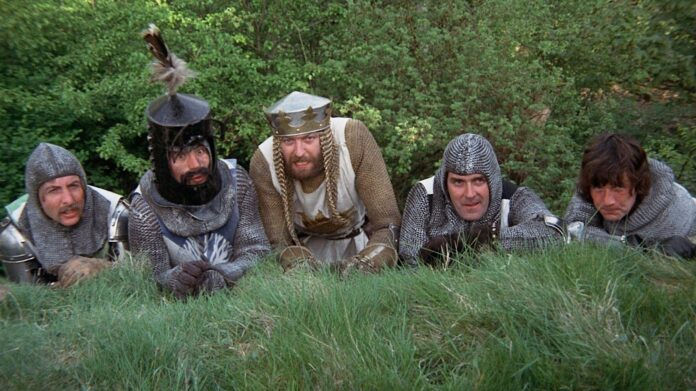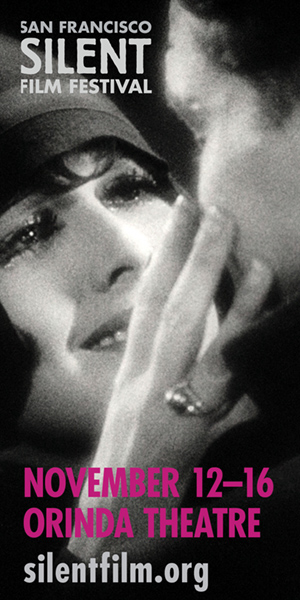1974 was a great year in the film history, the apex of “New Hollywood,” with its emphasis on complex stories for grownups. Some might argue from there it was all downhill: 1975 had the movie whose stupendous success started the whole industry re-orienting itself towards younger ticket-buyers and simpler concepts, even if Jaws itself remains pretty near-perfect entertainment. If that year didn’t match its immediate predecessor in terms of quality, there are still plenty of memorable titles that will be celebrating their 50th anniversary over the course of 2025. Some that loom very large now were in fact non-events at the time, notably The Rocky Horror Picture Show, a complete initial flop that only gradually found its audience once it began playing midnight shows later on.
Somewhat more successful from the start was Monty Python and the Holy Grail, which Fathom Events is reviving at theaters nationwide this Sun/4 and Wed/7. It did well in the U.K., and was the most popular 1975 UK release in the US (which admittedly isn’t saying a lot). Nonetheless, it barely got made—the Pythons’ prior feature And Now For Something Completely Different (which was mostly just restagings of their TV skits) had sunk without a trace, so when they pitched Grail, no studio was interested. Ergo they went begging directly to the fans, which happened to include a lot of British rock stars—so the still-relatively-minuscule budget was largely funded by Led Zeppelin, Pink Floyd, Elton John, and others for whom it was also a handy tax writeoff.
In the meantime, however, PBS began running Monty Python’s Flying Circus, starting the same year (1974) that the last of its original 45 episodes premiered on the BBC. That show had been slow to gain a following at home, its 1969 first series hardly stirring enough enthusiasm for a renewal. But its belated US bow caught on like wildfire, rapidly becoming public broadcasting’s biggest asset in many markets. So when Grail opened simultaneously on both sides of the Atlantic in the spring of ’75, there was already a significant American audience waiting for it. Still, I doubt anyone (including the six Pythons themselves) could have foreseen how it would turn into an eternal repertory staple—nearly as much so as Rocky Horror—or build their cult following into a sort of permanent empire. They’d already more or less broken up, then reunited to make the film. Grail ensured they’d never quite fully disentangle their careers from one another, or the Python “brand,” again.
I saw Monty Python and the Holy Grail when it came out, finagling my parents into driving me to something they’d have surely hated. (Conveniently, the theater’s other screen was playing the photographed stage play Give ‘Em Hell, Harry, with James Whitmore as Truman, which kept them otherwise occupied.) At age 14, I had pretty much the same reaction most grownup critics did: That it was very funny at times but had a lot of dead spots. Having probably not seen it whole since then, a rewatch last week proved not-too-surprisingly that the movie was simply ahead of its time—the lulls complained about then were in a mode of deadpan absurdist humor that I just wasn’t comfortably familiar yet. Now the pacing seems rather seamless, and the level of craftsmanship remarkably polished under dirt-cheap circumstances. (It cost about a quarter-million pounds to produce, not much more than Carry On Behind, another British comedy released that year.) While you’d assume the entire movie long was since committed to collective memory, I was amazed to have completely forgotten large swaths, including a whole modern-day thread with professor and police that ultimately terminates the Arthurian narrative.
Did the Pythons go on to make better films, as a group or individually? Maybe. But Holy Grail is peerless as a sustained goof, enlarging the sensibility of their TV skits to an epic canvas it simultaneously ridicules. The grandiosity of the library-music score and Scottish vistas are ideally undermined by Terry Gilliam’s collage animations, the ludicrous violence, every appearance by the minstrel (Bonzo Dog Dooh-Dah Band’s Neil Innes) providing live musical narration of Sir Robin’s (Eric Idle) “not-quite-so-brave-as-Sir-Lancelot’s” adventures, et al. A full list of theaters and showtimes for the 50th anniversary shows can be had here; SF venues include AMC Metreon and Regal Stonestown.
Alamo Drafthouse is hosting a more extensive celebration of 1975 releases this month and presumably beyond, starting with Kubrick’s ravishing Barry Lyndon—another costume epic, albeit one that cost about 40 times’ Grail’s budget, and looks it. That Sat/3 matinee is already sold out, alas. But still to come are Robert Altman’s magnum opus Nashville (Sun/4), Chantal Akerman’s minimalist landmark Jeanne Dielman, 23, quai du Commerce, 1080 Bruxelles (Sat/10) and Michael Schultz’s post-Blaxploitation classic Cooley High (Sun/18). You might want to make full evening of it on Mon/26, as there’s a 6pm show of Spielberg’s aforementioned Jaws, followed at 9:15 by Jack Hill’s grindhouse gem Switchblade Sisters.
Other special events happening this week include the already in-progress Doclands, running at the Smith Rafael Film Center in Marin Wed/30 through Sun/4. This latest edition for the California Film Institute’s annual nonfiction cinema showcase encompasses works from around the world, including three world-premiere features: The Invisible Mammal (about bats), Frozen in Time (animal life of the prehistoric Arctic), and Thaw (egg freezing as a modern procreational choice). Other topics on tap are online predation (Dangerous Games), Silicon Valley (The Dreamers and I), social justice (Free Leonard Peltier), redefining masculinity (Sons), pro-democracy struggles (Good Enough Ancestor), space exploration (Starman), climate change (Incandescence), music (I Need You: 53 Years of the Band America), mountaineering (The Last Expedition), whistleblowing (Middletown), art, sport, immigration, and much more. There will also be workshops for aspiring filmmakers. Full program, schedule and ticket info can be had here.
Starting this Fri/2 is at Berkeley’s BAMPFA is a short series commemorating one of the more singular long-term collaborations between a director and star. “Love Streams: Gena Rowlands & John Cassavetes” celebrates the on- and off-screen partnership of a husband and wife duo who became synonymous with a particularly raw, neorealist type of independent U.S. cinema in the 1960s and after. It begins with 1974’s A Woman Under the Influence, in which she played a working-class housewife whose escalating mental instability imperils her marriage (to Peter Falk). It was a bravura, Oscar-nominated turn that illustrated both the potential and pitfalls of Cassavetes’ heavily actor-indulgent approach to character and drama.
Help us save local journalism!
Every tax-deductible donation helps us grow to cover the issues that mean the most to our community. Become a 48 Hills Hero and support the only daily progressive news source in the Bay Area.
Later on the schedule, running through May 14, are the B&W suburban dissection Faces (1968); 1971’s comedy Minnie and Moscowitz, with Seymour Cassel as the other half of that odd couple; the 1978 Opening Night, in which Rowlands is a mercurial stage diva; 1980’s Gloria, another Oscar-nominated role, this time as a larger-than-life gun moll with a heart of gold; and Love Streams (1984), the last and most eccentric of their films together, casting the famous duo as brother and sister. Cassavetes died in 1989, while his widow went on to greatly enlarge her filmography in other people’s projects before passing away last year. Info on the entire series is here.
New films opening this week:
Bonjour Tristesse
Francoise Sagan’s first novel, published in 1954 when she was just 18, was such an international sensation that Hollywood made the first film adaptation—not a frequent occurrence then for European literature. Otto Preminger directed Jean Seberg, his ill-received discovery in the flop Saint Joan, and she was very good even if neither her performance or the (underrated) movie got much respect at the time. Still, after over nearly 70 years, there was certainly room for a remake…preferably one that made the characters French again, with French actors.
That would not be this version, a Canadian-German production in English from Canadian-Indian author Durga Chew-Bose, making her directorial debut. Nonetheless, its update of Sagan’s story works to a point, thanks to astute casting, alluring luxury-class atmospherics and a gorgeous piano score by Lesley Barber. Teenaged only child Cecile (Lily McInerny, from the excellent if little-seen 2022 Palm Trees and Power Lines) is spending a dolorous summer in the South of France with her widowed father (Claes Bang) and his current, much younger girlfriend Elsa (Nailia Harzoune), while amusing herself with cute peer Cyril (Aliocha Schneider). Father and daughter have the kind of “sophisticatedly” easygoing relationship in which she calls him “Raymond” and he doesn’t tell her what to do… ever. The ambiance changes a bit when they are visited by the late mother’s friend Anne (Chloe Sevigny). She takes a maternal interest in the girl—something Cecile finds irksome, having been given so much parental rope to date—which becomes more serious as Anne’s friendship with Raymond enters a new stage.
As observation of these privileged lives turns to melodrama, with our heroine scheming to preserve her status quo, this tale should acquire the urgency of a psychological thriller. That was something Preminger managed, but Chew-Bose stays on the placid surface. While her actors are fine individually, their relationships to one another aren’t defined very well, dulling the eventual conflicts. The director-adaptor at times seems more interested in lingering on details of clothes, food, sexy idleness than in driving a plot towards tragic cumulative impact. We ought to actually care about these people, but we don’t; it’s a decent-enough film that should have been better. Bonjour Tristesseopens Fri/2 at the Smith Rafael Film Center.
The Surfer
Like Tom Cruise jumping out of planes or Johnny Depp being “quirky,” there are now certain expectations that come with seeing Nicolas Cage in a movie—in particular, that he will go over-the-top in one way or another. That can be a good or a bad thing. In his last release, Gunslingers, it was a very bad, hammy, annoying thing. This latest from Irish director Lorcan Finnegan makes it a plus, Thomas Martin’s script fully justifying its star’s showy descent into madness. The unnamed title character is some sort of failed yuppie who’s evidently already alienated his wife (unseen here) and son (Finn Little), but is trying to win them back by buying a house his family once owned on Australia’s west coast, where he lived as a child. (A subsequent move to the US explains our protagonist’s Yank accent.)
The son surfs, and dad wants very much to show him the cove where he too once pursued “the perfect wave.” But a bullying pack of local wannabe “surf gangsters” intimidate any outsiders from sharing their spot, though it’s officially a public beach. The son scrams from this unpleasant encounter, but his father sticks around… the confrontations escalating over hours, then days, as his shoes, phone, and more get stolen, leaving him looking very much like some homeless guy who “lives” in the cliffside parking lot. An increasingly hallucinatory progress makes us suspect he might be just that, any assumption of respectability just delusions in an untethered mind.
Finnegan’s prior features were all intriguing horror-adjacent concepts that worked better in stylistic than story-development terms. The Surfer is his most accomplished work to date, in large part because he has a new writer—and Martin manages to sustain his twisty Twilight Zone-esque conceit to the end, or almost. (It’s somewhat frustrating that the fadeout leaves you with more questions than sense of resolution.) There are conspicuous nods to 1970s paranoid Australian cult cinema classics like Wake in Fright and Long Weekend, but it took me until halfway through to realize the biggest influence is John Cheever-derived 1968 Burt Lancaster vehicle The Swimmer, another murky nightmare allegory of eroding alpha-male confidence.
Being sold as a simple vigilante thriller, this is in fact a much fancier package of slippery reality amplified both by Cage’s disheveled desperation and a full gamut of disorienting audiovisual devices. It’s not perfect, but it’s a trip. The Surfer opens Fri/2 in theaters nationwide, including SF’s Balboa.
Blue Sun Palace
As quietly minimalist as The Surfer is flamboyantly maximalist, Constance Tsang’s debut feature trains eye on immigrant lives well hidden from everyday view. Amy (Wu Ke-xi) and Didi (Haipeng Xu) are two Chinese emigres living and working in a Queens massage parlor, dreaming of opening a restaurant together in Baltimore. Their friendship, and solidarity with the others employed there, brightens a somewhat dreary existence that sometimes encompasses providing reluctant sexual favors for customers—then getting shortchanged by them.
Then an armed robbery abruptly, drastically changes everything for our heroines. In the aftermath, one of them must figure out how to go on, while navigating a tentative relationship with sad-sack Cheung (Lee Kang-sheng) that’s driven less by attraction than shared grief. Arguably overlong at two full hours for its very small, minutely observed story, Palace nonetheless has an air of patient poetry that turns the mundane into something melancholy, moving, and a bit spectral. It opens at SF’s Roxie Theater Fri/2.
New Music Docs: Bjork, Mogwai
Likewise reaching for the transcendent in their very different ways are two long-running music acts showcased in new documentaries. Isold Uggadottir’s Bjork: Cornucopia is a record of the Icelandic performer’s titular stage spectacular, which was largely built around songs from her 2017 album Utopia, and toured the world for several years. This particular show was captured in Lisbon; a shorter version got released to Apple platforms in January, while this extended cut also includes three separate music videos after the live footage.
The concert is undeniably stupendous in design terms—“visual director” Bjork, who wears a commedia-style facial mask throughout, is just one player in a theatrical landscape of computer animations, elaborate costumes and eccentric musical collaborators. (The latter include a flute ensemble, harps, women’s choir, and a percussionist who at one point “plays” poured buckets of water.) The aesthetic effect is a singular mix of Kabuki futurism meets fancy-dress rave in an aquarium, with the fantastical-sculptural influence of the star’s ex-spouse Matthew Barney often palpable.
I’ll admit Bjork is a taste I’ve never quite acquired, a few songs aside. Her vocal quirks, ESL lyrics (rather painfully subtitled here) and amorphous compositions land on the wrong side of twee for me. But she is like no one else—a huge credit in an era of depressingly look-and-soundalike pop divas. If you’re a fan, this high-end memento of an impressively imaginative multimedia package will be nirvana. It opens at the Roxie, Balboa, Alamo Drafthouse, Smith Rafael and other Bay Area theaters on Wed/7, playing some venues that day only; for more info, go here.
Equally unique in the rock/post-rock universe is Scottish quartet Mogwai, who for a quarter-century now have carved their own sonic path making mostly instrumental music variably majestic, thundering and meditatively lyrical. Or as someone describes it in Antony Crook’s If the Stars Had a Sound, “sometimes very loud but often quiet and spare.” This documentary is pretty much a love letter to the band, focusing on the release of 2021 album As the Love Continues (recorded during COVID lockdown), which might provide their first #1 debut on the UK charts.
That would be a big leap for a group so thoroughly removed from popular trends, though as myriad voices testify here, Mogwai incites an almost religious devotion in their fanbase. Which base is the best audience for the film, as it doesn’t provide much insight into the individual members or their collective creative process. The casual enthusiast or newbie won’t come away with as much intel as you might’ve hoped. Still, Stars is a worthy tribute. It became available on digital download, dvd and blu-ray from Lightbulb as of April 28.





